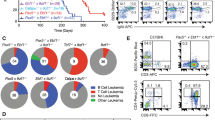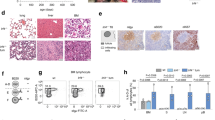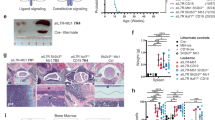Abstract
B lymphopoiesis begins in the fetal liver, switching after birth to the bone marrow, where it persists for life. The unique developmental outcomes of each phase are well documented, yet their molecular requirements are not. Here we describe two allelic X-linked mutations in mice that caused cell-intrinsic arrest of adult B lymphopoiesis. Mutant fetal liver progenitors generated B cells in situ but not in irradiated adult bone marrow, which emphasizes a necessity for the affected pathway only in the context of adult bone marrow. The causative mutations were ascribed to Atp11c, which encodes a P4-type ATPase with no previously described function. Our data establish an essential, cell-autonomous and context-sensitive function for ATP11C, a putative aminophospholipid flippase, in B cell development.
This is a preview of subscription content, access via your institution
Access options
Subscribe to this journal
Receive 12 print issues and online access
$209.00 per year
only $17.42 per issue
Buy this article
- Purchase on Springer Link
- Instant access to full article PDF
Prices may be subject to local taxes which are calculated during checkout







Similar content being viewed by others
References
Hardy, R.R. & Hayakawa, K. B cell development pathways. Annu. Rev. Immunol. 19, 595–621 (2001).
Lopes-Carvalho, T., Foote, J. & Kearney, J.F. Marginal zone B cells in lymphocyte activation and regulation. Curr. Opin. Immunol. 17, 244–250 (2005).
Tung, J.W. & Herzenberg, L.A. Unraveling B-1 progenitors. Curr. Opin. Immunol. 19, 150–155 (2007).
Hao, Z. & Rajewsky, K. Homeostasis of peripheral B cells in the absence of B cell influx from the bone marrow. J. Exp. Med. 194, 1151–1164 (2001).
Carvalho, T.L., Mota-Santos, T., Cumano, A., Demengeot, J. & Vieira, P. Arrested B lymphopoiesis and persistence of activated B cells in adult interleukin 7−/– mice. J. Exp. Med. 194, 1141–1150 (2001).
Sitnicka, E. et al. Complementary signaling through flt3 and interleukin-7 receptor α is indispensable for fetal and adult B cell genesis. J. Exp. Med. 198, 1495–1506 (2003).
Kikuchi, K. & Kondo, M. Developmental switch of mouse hematopoietic stem cells from fetal to adult type occurs in bone marrow after birth. Proc. Natl. Acad. Sci. USA 103, 17852–17857 (2006).
von Freeden-Jeffry, U. et al. Lymphopenia in interleukin (IL)-7 gene-deleted mice identifies IL-7 as a nonredundant cytokine. J. Exp. Med. 181, 1519–1526 (1995).
Kikuchi, K., Lai, A.Y., Hsu, C.L. & Kondo, M. IL-7 receptor signaling is necessary for stage transition in adult B cell development through up-regulation of EBF. J. Exp. Med. 201, 1197–1203 (2005).
Dias, S., Silva, H., Cumano, A. & Vieira, P. Interleukin-7 is necessary to maintain the B cell potential in common lymphoid progenitors. J. Exp. Med. 201, 971–979 (2005).
Malin, S. et al. Role of STAT5 in controlling cell survival and immunoglobulin gene recombination during pro-B cell development. Nat. Immunol. 11, 171–179 (2010).
Lin, H. & Grosschedl, R. Failure of B-cell differentiation in mice lacking the transcription factor EBF. Nature 376, 263–267 (1995).
Busslinger, M. Transcriptional control of early B cell development. Annu. Rev. Immunol. 22, 55–79 (2004).
Yabas, M. et al. ATP11C is critical for the internalization of phosphatidylserine and differentiation of B lymphocytes. Nat. Immunol. advance online publication, doi:10.1038/ni.2011 (20 March 2011).
Nelms, K.A. & Goodnow, C.C. Genome-wide ENU mutagenesis to reveal immune regulators. Immunity 15, 409–418 (2001).
Hardy, R.R., Carmack, C.E., Shinton, S.A., Kemp, J.D. & Hayakawa, K. Resolution and characterization of pro-B and pre-pro-B cell stages in normal mouse bone marrow. J. Exp. Med. 173, 1213–1225 (1991).
Karasuyama, H. et al. The expression of Vpre-B/λ5 surrogate light chain in early bone marrow precursor B cells of normal and B cell-deficient mutant mice. Cell 77, 133–143 (1994).
Jensen, C.T. et al. FLT3 ligand and not TSLP is the key regulator of IL-7-independent B-1 and B-2 B lymphopoiesis. Blood 112, 2297–2304 (2008).
Watanabe-Fukunaga, R., Brannan, C.I., Copeland, N.G., Jenkins, N.A. & Nagata, S. Lymphoproliferation disorder in mice explained by defects in Fas antigen that mediates apoptosis. Nature 356, 314–317 (1992).
Bouillet, P. et al. Proapoptotic Bcl-2 relative Bim required for certain apoptotic responses, leukocyte homeostasis, and to preclude autoimmunity. Science 286, 1735–1738 (1999).
Strasser, A. et al. Enforced BCL2 expression in B-lymphoid cells prolongs antibody responses and elicits autoimmune disease. Proc. Natl. Acad. Sci. USA 88, 8661–8665 (1991).
Herzog, S., Reth, M. & Jumaa, H. Regulation of B-cell proliferation and differentiation by pre-B-cell receptor signalling. Nat. Rev. Immunol. 9, 195–205 (2009).
Brink, R. et al. Immunoglobulin M and D antigen receptors are both capable of mediating B lymphocyte activation, deletion, or anergy after interaction with specific antigen. J. Exp. Med. 176, 991–1005 (1992).
Phan, T.G. et al. B cell receptor-independent stimuli trigger immunoglobulin (Ig) class switch recombination and production of IgG autoantibodies by anergic self-reactive B cells. J. Exp. Med. 197, 845–860 (2003).
Pelanda, R., Schaal, S., Torres, R.M. & Rajewsky, K. A prematurely expressed Igκ transgene, but not VκJκ gene segment targeted into the Igκ locus, can rescue B cell development in λ5-deficient mice. Immunity 5, 229–239 (1996).
Spanopoulou, E. et al. Functional immunoglobulin transgenes guide ordered B-cell differentiation in Rag-1-deficient mice. Genes Dev. 8, 1030–1042 (1994).
Chang, Y.F., Imam, J.S. & Wilkinson, M.F. The nonsense-mediated decay RNA surveillance pathway. Annu. Rev. Biochem. 76, 51–74 (2007).
Su, A.I. et al. A gene atlas of the mouse and human protein-encoding transcriptomes. Proc. Natl. Acad. Sci. USA 101, 6062–6067 (2004).
Bull, L.N. et al. A gene encoding a P-type ATPase mutated in two forms of hereditary cholestasis. Nat. Genet. 18, 219–224 (1998).
Kühlbrandt, W. Biology, structure and mechanism of P-type ATPases. Nat. Rev. Mol. Cell Biol. 5, 282–295 (2004).
Tang, X., Halleck, M.S., Schlegel, R.A. & Williamson, P. A subfamily of P-type ATPases with aminophospholipid transporting activity. Science 272, 1495–1497 (1996).
Holthuis, J.C. & Levine, T.P. Lipid traffic: floppy drives and a superhighway. Nat. Rev. Mol. Cell Biol. 6, 209–220 (2005).
Leventis, P.A. & Grinstein, S. The distribution and function of phosphatidylserine in cellular membranes. Annu Rev Biophys. 39, 407–427 (2010).
Dykstra, M., Cherukuri, A., Sohn, H.W., Tzeng, S.J. & Pierce, S.K. Location is everything: lipid rafts and immune cell signaling. Annu. Rev. Immunol. 21, 457–481 (2003).
Guo, B., Kato, R.M., Garcia-Lloret, M., Wahl, M.I. & Rawlings, D.J. Engagement of the human pre-B cell receptor generates a lipid raft-dependent calcium signaling complex. Immunity 13, 243–253 (2000).
Fruman, D.A. & Cantley, L.C. Phosphoinositide 3-kinase in immunological systems. Semin. Immunol. 14, 7–18 (2002).
Anzelon, A.N., Wu, H. & Rickert, R.C. Pten inactivation alters peripheral B lymphocyte fate and reconstitutes CD19 function. Nat. Immunol. 4, 287–294 (2003).
Janas, M.L. et al. The effect of deleting p110δ on the phenotype and function of PTEN-deficient B cells. J. Immunol. 180, 739–746 (2008).
Miosge, L.A. & Goodnow, C.C. Genes, pathways and checkpoints in lymphocyte development and homeostasis. Immunol. Cell Biol. 83, 318–335 (2005).
Raff, M.C., Megson, M., Owen, J.J. & Cooper, M.D. Early production of intracellular IgM by B-lymphocyte precursors in mouse. Nature 259, 224–226 (1976).
Peschon, J.J. et al. Early lymphocyte expansion is severely impaired in interleukin 7 receptor-deficient mice. J. Exp. Med. 180, 1955–1960 (1994).
Grabstein, K.H. et al. Inhibition of murine B and T lymphopoiesis in vivo by an anti-interleukin 7 monoclonal antibody. J. Exp. Med. 178, 257–264 (1993).
Vosshenrich, C.A., Cumano, A., Müller, W., Di Santo, J.P. & Vieira, P. Thymic stromal-derived lymphopoietin distinguishes fetal from adult B cell development. Nat. Immunol. 4, 773–779 (2003).
Purohit, S.J. et al. Determination of lymphoid cell fate is dependent on the expression status of the IL-7 receptor. EMBO J. 22, 5511–5521 (2003).
Roessler, S. et al. Distinct promoters mediate the regulation of Ebf1 gene expression by interleukin-7 and Pax5. Mol. Cell. Biol. 27, 579–594 (2007).
Kikuchi, K., Kasai, H., Watanabe, A., Lai, A.Y. & Kondo, M. IL-7 specifies B cell fate at the common lymphoid progenitor to pre-proB transition stage by maintaining early B cell factor expression. J. Immunol. 181, 383–392 (2008).
Eidenschenk, C. et al. Flt3 permits survival during infection by rendering dendritic cells competent to activate NK cells. Proc. Natl. Acad. Sci. USA 107, 9759–9764 (2010).
Croker, B.A. et al. Inflammation and autoimmunity caused by a SHP1 mutation depend on IL-1, MyD88, and a microbial trigger. Proc. Natl. Acad. Sci. USA 105, 15028–15033 (2008).
Georgel, P., Du, X., Hoebe, K. & Beutler, B.A. ENU mutagenesis in mice. Methods Mol. Biol. 415, 1–16 (2008).
Rickert, R.C., Rajewsky, K. & Roes, J. Impairment of T-cell-dependent B-cell responses and B-1 cell development in CD19-deficient mice. Nature 376, 352–355 (1995).
Gavin, A.L. et al. Adjuvant-enhanced antibody responses in the absence of toll-like receptor signaling. Science 314, 1936–1938 (2006).
Acknowledgements
We thank M. Gutierrez for animal care; T. Robinson, S. Kalina and C. Ross for genotyping; C. Goodnow (John Curtin School of Medical Research) and R. Brink (Garvan Institute) for mice; A. Feeney for discussions; and D. La Vine for Figure 6f. Supported by the Bill & Melinda Gates Foundation, the National Institute of Allergy and Infectious Diseases of the National Institutes of Health (HHSN272200700038C to (B.B.), The General Sir John Monash Foundation (O.M.S.) and the Cancer Research Institute (C.N.A.).
Author information
Authors and Affiliations
Contributions
O.M.S. designed and did experiments, analyzed data and wrote the paper under the guidance of B.B.; C.N.A. and E.P. identified the spelling phenotype and assisted with immunization experiments; Y.X. and P.L. assisted with positional cloning and mutation identification; and C.H. measured immunoglobulin isotypes with reagents that D.N. contributed.
Corresponding author
Ethics declarations
Competing interests
The authors declare no competing financial interests.
Supplementary information
Supplementary Text and Figures
Supplementary Figures 1–5 (PDF 3330 kb)
Rights and permissions
About this article
Cite this article
Siggs, O., Arnold, C., Huber, C. et al. The P4-type ATPase ATP11C is essential for B lymphopoiesis in adult bone marrow. Nat Immunol 12, 434–440 (2011). https://doi.org/10.1038/ni.2012
Received:
Accepted:
Published:
Issue Date:
DOI: https://doi.org/10.1038/ni.2012
This article is cited by
-
ATP9A deficiency causes ADHD and aberrant endosomal recycling via modulating RAB5 and RAB11 activity
Molecular Psychiatry (2023)
-
ATP11C promotes the differentiation of pre-B cells into immature B cells but does not affect their IL-7-dependent proliferation
Immunologic Research (2023)
-
The role of phosphatidylserine on the membrane in immunity and blood coagulation
Biomarker Research (2022)
-
The ratio of ATP11C/PLSCR1 mRNA transcripts has clinical significance in sickle cell anemia
Annals of Hematology (2022)
-
Changes in bursal B cells in chicken during embryonic development and early life after hatching
Scientific Reports (2018)



